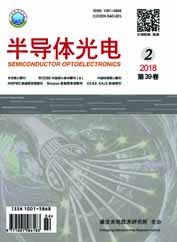带隙渐变纳米线的光电导淬灭效应
[1] Kempa T, Day R, Kim S, et al. Semiconductor nanowires: A platform for exploring limits and concepts for nano-enabled solar cells[J]. Energy & Environmental Science, 2013, 6(7): 19-33.
[2] Pokhrel S, Simion C E, Teodorescu V S, et al. Synthesis, mechanism and gas-sensing application of surfactant tailored tungsten oxide nanostructures[J]. Adv. Funct. Mater., 2009, 19(11): 1767-1774.
[3] Teoh W Y, Amal R, Madler L. Flame spray pyrolysis: an enabling technology for nanoparticles design and fabrication[J]. Nanoscale, 2010, 2(13): 24-47.
[4] Pokhrel S, Birkenstock J, Schowalter M, et al. Growth of ultrafine single crystalline WO3 nanoparticles using flame spray pyrolysis[J]. Crystal Growth & Design, 2010, 10(2): 632-639.
[5] Kemmler J A, Pokhrel S, Birkenstock J, et al. Quenched, nanocrystalline ISns on high temperature phase for gas sensing applications[J]. Sensors and Actuators B, 2012, 161(7): 40-47.
[6] Nel A E, Madler L, Velegol D, et al. Understanding biophysi cochemical interactions at the nano-bio interface[J]. Nature Materials, 2009, 8(7): 543-557.
[7] Law M, Goldbeiger J, Yang P D. Semiconductor nanowires and nanotubes[J]. Annual Rev. of Mater. Research, 2004, 34(3): 83-122.
[8] De Franceschi S, Van Dam J A, Bakkers E, et al. Single-electron tunneling in InP nanowires[J]. Appl. Phys. Lett., 2003, 83(2): 344-346.
[9] Zhong Z, Fang Y, Lu W, et al. Coherent single charge transport in molecular-scale silicon nanowires[J]. Nano Lett., 2005, 5(6): 1143-1146.
[10] Bjork M T, Thelander C, Hansen A E, et al. Few-electron quantum dots in nanowires[J]. Nano Lett., 2004, 4(9): 1621-1625.
[11] 范志东, 周子淳, 刘 绰, 等. Eu掺杂Si纳米线的光致发光特性[J]. 物理学报, 2015, (14): 351-355. Fan Zhidong, Zhou Zichun, Liu Chuo, et al. Photoluminescence properties of Eu doped Si nanowires[J]. Acta Physica Sinica, 2015, (14): 351-355.
[12] Pan Anlian, Liu Ruibin, Sun Minghua, et al. Spatial composition grading of quaternary ZnCdSSe alloy nanowires with tunable light emission between 350 and 710nm on a single substrate[J]. Acs Nano., 2010, 4(2): 671-680.
[13] Gu Fuxing, Yang Zongyin, Yu Huakang, et al. Spatial bandgap engineering along single alloy nanowires[J]. Am. Chem. Soc, 2011, 133(133): 2037-2039.
[14] Bube R H. Photoelectronic Properties of Semiconductors[M]. Cambridge: Cambridge University Press, 1992, 1(1): 78-96.
[15] Hou Q F, Wang X L, Xiao H L, et al. Variation of optical quenching of photoconductivity with resistivity in unintentional doped GaN[J]. Chin. Phys. Lett., 2010, 27(27): 57-104.
[16] Cai S, Parish G, Umana-Membreno G A, et al. Optical quenching of photoconductivity in undoped n-GaN[J]. Appl. Phys., 2004, 95(95): 1081-1088.
[17] Huang Z C, Mott D B, Shu P K, et al. Optical quenching of photoconductivity in GaN photoconductors[J]. Appl. Phys., 1997, 82(82): 2707-2709.
[18] Lin T Y, Yang H C, Chen Y F. Optical quenching of the photoconductivity in n-type GaN[J]. Appl. Phys., 2000, 87(87): 3044-3048.
[19] Ursaki W, Tiginyanu I M, Ricci P C, et al. Persistent photoconductivity and optical quenching of photocurrent in GaN layers under dual excitation[J]. Appl. Phys., 2003, 94(38): 75-82.
[20] Bube R H. Infrared quenching and a unified description of photoconductivity phenomena in cadmium sulfide and selenide[J]. Phys. Rev., 1955, 99(11): 1105-1116.
[21] Grabner L. Optical quenching of photoconductivity near the band edge in CdS[J]. Phys. Rev. Lett., 1965, 14(5): 551-554.
[22] Gu F, Zhang L, Yu H, et al. Large defect-induced sub-bandgap photoresponse in semiconductor nanowires via waveguiding excitation[J]. Nanotechnol., 2011, 22(425): 425201-425205.
[23] Reimers P. Preparation of graded-band-gap single crystals of Ⅱ-Ⅵ compounds[J]. Physica Status Solidi, 1969, 35(2): 707-716.
[24] Reimers P, Ruppel W. Preparation of CDS-CDSE graded single crystals[J]. Physica Status Solidi, 1968, 29(1): 31-33.
刘敦伟, 袁光立, 安辉耀, 石雪梅, 于涛. 带隙渐变纳米线的光电导淬灭效应[J]. 半导体光电, 2018, 39(2): 206. LIU Dunwei, YUAN Guangli, AN Huiyao, SHI Xuemei, YU Tao. Magical Quenching Effect of Gradient Band Gap CdSSe Nanowire[J]. Semiconductor Optoelectronics, 2018, 39(2): 206.



